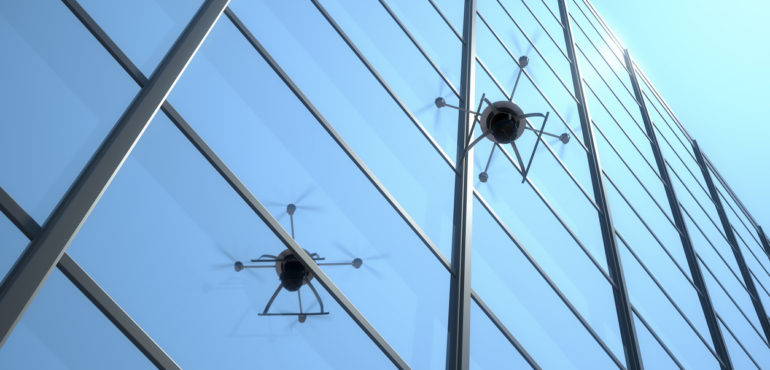Eyes in the sky – an introduction to drones
When the word ‘drone’ first entered the public lexicon, it was in the form of a new weapon of war used by the US Military. The bulbous profile of the Predator combat drone with its payload of Hellfire missiles came to be seen by much of the world as the ‘face’ of American global power projection. Here was a machine, piloted by a crew sitting in a small room thousands of miles away capable of striking targets across the world. As modern fighter jets push the limits of the human biology to cope with g-force and acceleration, there are voices calling for the construction of ship-borne ‘drone hives’. Large carriers packed with ‘fighter drones’ whose only limits would be the skill of the engineers who built them.
As miniaturisation, wireless technology and computer software increased in sophistication, the drone stopped being a solely military concept and arrived in the civilian market. Small camera equipped drones have been used for tasks ranging from nature conservation to landscape surveying and film production. There are even now ‘drone races’ where people compete against each other to complete laps of a course flying ‘racing drones’ at breakneck speed.
Various companies are also seeing the potential benefit of drones for security with several start-ups beginning to combine machine learning with drone technology to monitor large sites. These companies are still in their infancy and far from heading to market[1] but the applications of drone technology to security companies is likely to be considerable.
Although it is always exciting to watch a new technology take-off, there are still many questions surrounding drones both legal and ethical that have yet to be answered. Firstly, what are drones? Are they a toy? Are they an aircraft? If they are an aircraft, then they must be governed by strict aviation rules and regulations. Acquiring a drone should only be possible for those holding a ‘drone licence’ just like any other pilot. If they are just a toy, then should a toy be capable of interrupting air traffic, carry a payload and put cameras into the private property of others?
Drone technology has also not gone unnoticed by other less savoury parties, who have been quick to recognise the value of a small unmanned aerial vehicle with good lift capacity and an HD Camera.
Terrorism
Several insurgent groups have repeatedly used drones as ad-hoc ‘bombers’ in Syria and Iraq. A drone would often be armed with a single 40mm grenade in a tube, which can be dropped on a target to cause as much damage as possible. Many armoured vehicles only have armour plate on the sides and bottom to better cope with roadside bombs and rocket attacks but few have significant armour on the roof. Even a small bomb when dropped on the top of an armoured vehicle can therefore be devastating. The sound of the drone will also be drowned out by the sound of the targets engine allowing for precision strikes into exposed areas and open hatches which further increases the potential for harm.
Mercifully, the use of drones to conduct aerial attacks has been restricted so far to Iraq and Syria but there is no stopping a potential terrorist returning to Europe bringing ideas of drone warfare back with them. A small device might be effective against a moving armoured car, a packed crowd is another matter entirely.
Even a small device dropped into a crowded area such as a football stadium would cause mass panic regardless of casualties. Current threats rely on using humans or conventional vehicles as a primary vector for guns or explosives, but a drone can fly far above metal detectors or security scans to deliver its payload. Drones are small, hard to detect and potentially give a terrorist time to strike multiple times before they are caught. In this way, they are the perfect delivery vehicle for small scale attacks. Event organisers should therefore have full contingency plans in place to deal with such an incident, or likely risk being caught by surprise.
Crime
When it comes to committing a crime, a key feature for criminals (especially professional criminals) is what is called the targeting phase. This is where a criminal (or criminals) gather information on a target before making a move. For crimes such as burglary this chiefly involves learning and studying the routines of home owners, ascertaining their level of wealth and looking for security features such as lights and cameras. Skilled criminals build up ‘dossiers’ of homes that have been deemed good targets that will then be systematically broken into over a period of months.
Criminals are both smart and adaptable and will frequently incorporate new technology to their advantage. Reports have already shown that criminal groups will use social media to check whether people are on holiday. They have also used social media posts to ascertain whether someone has something worth taking. Kim Kardashian was promptly robbed at gunpoint when she posted pictures of her jewellery online.
Drones expand the criminal arsenal further. At present, you do not need a licence to operate a drone under 20kgs in weight as long as it remains in the line of sight of the controller. Policing these rules however is near impossible as a drone’s operator can remain hidden while flying their machine. In crowded or urban areas, it becomes very hard to work out where the drone is being flown from and there have been multiple cases of drones being used to peek into houses in areas such as Knightsbridge and Mayfair. A drone can quietly and quickly survey an area, check to see if owners are home and even allow criminals to take notes on current security systems all without showing their face once. Drones have also been used by criminals to record peoples PIN numbers and even deliver drugs and contraband into prisons.[2]
Solving the drone problem
At present there are few rules regulating drones and those which do exist are notoriously difficult to enforce. After all, police time is limited especially in this era of diminishing budgets. Reporting illegal drone activity is unlikely to draw much of a response from an overstretched and overworked force.
The onus is therefore on the homeowner to take action to prevent drones ‘peeking’ into their property. If a drone is under 500 ft and directly over your property, it is ‘on’ your land and has the same rules applying to it as an errant football kicked into your garden. You could give it back, keep it for yourself or even destroy it.
Much as though it might be an amusing spectacle to hunt drones with a shotgun or set up some sort of automatic anti-aircraft cannon to shoot down intruding machines this is not a viable (or legally sensible) strategy. Thankfully there are solutions available that can be used to successfully deal with the problem without getting in trouble.
Capture, control or disable?
It is possible to seize control of a drone and either land it and capture it or else fly it in another direction. Blackstone Consultancy has tried this method in an ad hoc way to assist a client who was suffering problems with individuals using drones to record events going on at their company. We combined a universal controller with a signal booster and a signal scanner. When a drone was spotted, the frequency used to control it was drowned out by a stronger signal produced by the team. The drone would then be controlled and landed safely where it was then handed into lost property. Unsurprisingly, no-one came to collect the machines which were then sold and the money donated to charity.
A better system is one currently being developed that seizes control of any detected drone that comes within the property boundary and simply forces it to fly in the opposite direction. This is probably the best solution, as it both solves the problem without the need to get involved personally.
But the most romantic (and certainly dramatic) way of dealing with drones is to have a trained eagle. The Dutch police have been training eagles to take down drones with some success and there are already plenty of examples of drones being destroyed by eagles and falcons in the wild. Interestingly much like a bird, drones with their ground pointing cameras and inability to see above them are vulnerable to the attack strategies used by most birds of prey. Hawks and eagles hunt for food by appearing above their prey and then attacking from a blind spot before their meal has a chance to react. Though having an eagle to tear apart trespassing drones is effective, unless an individual has a real interest in falconry this strategy is probably best left for the professionals.
It is clear however, that as technology advances further and cameras and drones get smaller and smaller, commercial solutions need to be developed to prevent the threat and nuisance of drones. In addition, a legal framework should be put in place that allows for easier prosecution of those caught misusing drones for criminal purposes. Perhaps just as pressingly, home and property privacy laws should also be reviewed as currently none exist in the UK. Drones have yet to become a ubiquitous sight in our skies, but when they do we should be prepared for the consequences of their use.
[1] https://techcrunch.com/2016/08/22/drone-startup-aptonomy-has-created-robotic-flying-security-guards/
[2] http://www.independent.co.uk/news/uk/home-news/drones-police-crime-reports-uk-england-safety-surveillance-a7155076.html










